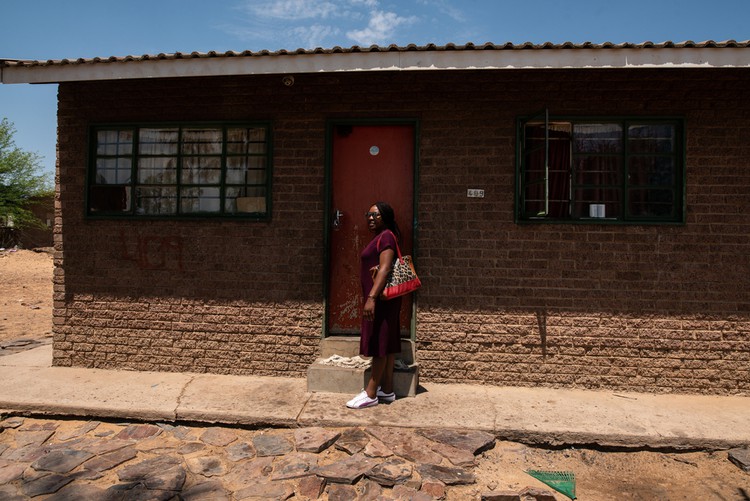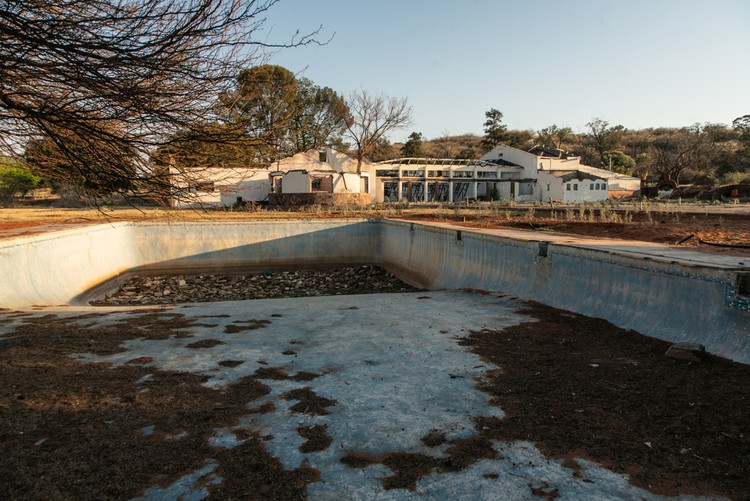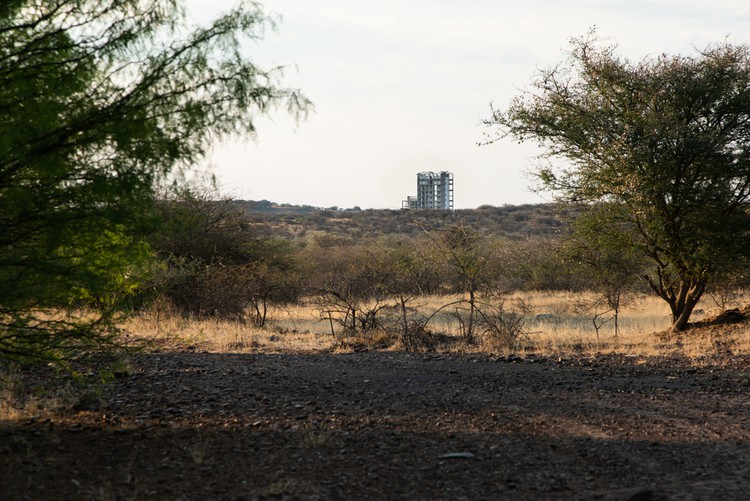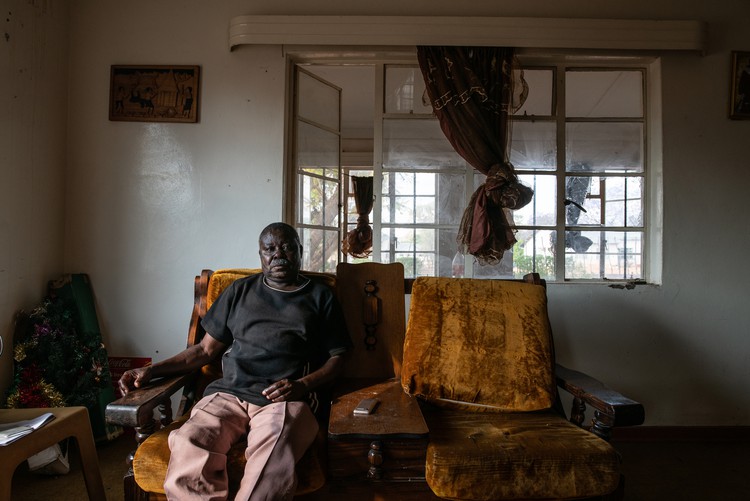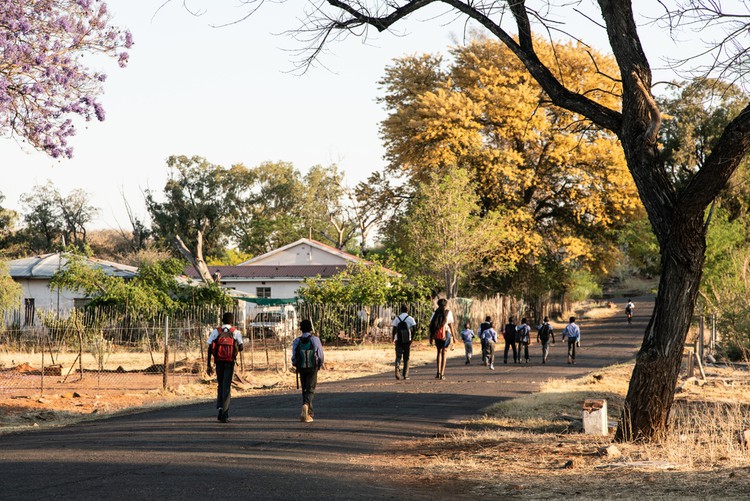32 Battalion veterans left in limbo in forgotten military town
Pomfret is in decline and its 3,000 Portuguese speaking residents face an uncertain future
As the midday sun beats down on the desert town of Pomfret in North West Province, 29-year-old Marcela Viemba pushes open a crooked metal gate and walks across a barren yard towards the front door of a forlorn red brick bungalow with a terracotta roof.
“This used to be my home,” Viemba says, turning to look at the varying states of collapse of other properties on either side of the tree-lined street. “It used to be so nice here in Pomfret, but it’s not a place to live anymore.”
Viemba moved to Pomfret, a former asbestos mine camp, at just three months old. Her father was among a group of Angolan soldiers who fought for apartheid South Africa’s notorious 32 Battalion. They were settled here with their families in 1989 at the end of the Border War, when Namibia gained independence and Pomfret became a South African military base.
Although residents still consider themselves Angolan, and Portuguese remains the lingua franca, they are all South African citizens and many have known no home but Pomfret. Only a handful of the 100 or so remaining military veterans have ever returned to Angola.
But the future of this uniquely homogenous community has become increasingly uncertain since the military base was closed in 2000 and ownership was transferred to the Department of Public Works.
Various departments of local and national government have stated their intention to relocate residents and demolish the town, citing the alleged risk of asbestos-related illnesses stemming from the old mine, which is visible on a hillside just beyond the perimeter of the town itself.
Marcela Viemba, who moved to Mahikeng in 2008, stands outside her former home in Pomfret.
Most recently, an October 2017 report by the Department of Planning, Monitoring and Evaluation stated: “The discovery of asbestos contamination in Pomfret renders the environment unsafe and unclean. Allowing the community to remain in such a condition is a fundamental violation of their human rights.”
Some current residents told GroundUp there were rumours they’d all be moved out by the end of 2018. But it has been 13 years since Pomfret residents were first made aware of a sluggish relocation plan and approximately 3,000 of the original 5,000 inhabitants still remain, almost all of them black Angolan family members and descendants of the original veterans. The few white military families who once lived here have long since departed. Those left behind have watched their town gradually deteriorate around them.
Much of the town was ravaged by looters after the local police station was shuttered in 2005 or torn down by police officers deployed to Pomfret during various phases of relocation that took place over the course 2008, when scores of families, including Viemba’s, were moved to RDP houses in Mahikeng.
Viemba comes back to Pomfret to visit family once every year or so and is still visibly upset by the dereliction. Among the ruins are a former clinic now used as a dump site, three empty public swimming pools and a dilapidated sports club that was once equipped with plush squash and tennis courts and a grand hall for hosting concerts and film screenings.
A 2008 court interdict put a temporary halt to the relocations and the accompanying demolition of the town, but it hasn’t stopped the steady erosion of services. Eskom shut off the electricity in December 2014, which subsequently interrupted the water supply. Residents have since had to fill water containers from rain tanks or the few public boreholes scattered across town.
“I grew up here. It was a beautiful place. To see the way it’s going downhill, it’s truly terrible,” said a local spaza shop owner who spoke to GroundUp on condition of anonymity.
With the nearest major urban centre of Vryburg more than two hours’ drive away, no job prospects in town and veterans on paltry pensions often having to purchase groceries on credit, he added that “business is terrible”.
The combination of socioeconomic woes and military heritage has led many Pomfret veterans and their male descendants to join controversial private security outfits in conflict zones as far away as Kosovo and Iraq.
“If you’re from Pomfret you aren’t really exposed to another way of life,” says Martin Antonio, a former resident who now owns businesses in the security sector in Pretoria. “So there will always be people from Pomfret going into that kind of job because they don’t see any other option.”
Antonio says that this is compounded by the stigma that Pomfret residents face in the job sector due to the town’s uncomfortable association with apartheid: “When you apply for a job and then you say you’re from Pomfret, automatically they look at you as a traitor. So your application will not be considered.”
According to Adrian Vorster, an advocate who represented the Pomfret community for more than five years, it was the town’s chequered past rather than the alleged asbestos contamination that prompted the initial government relocation attempts, which were first announced to the community in 2005.
This was just a year after more than 60 mercenaries were arrested in Harare in connection with an alleged coup plot against Equatorial Guinea’s longstanding dictator, Teodoro Obiang Nguema. Many of the mercenaries were former members of 32 Battalion.
Pomfret used to have three public swimming pools, all of which are now empty and long since out of use.
“Pomfret was seen as a mercenary pool. It was an embarrassment to the ANC government that South African citizens were arrested and many were from Pomfret. The government was also worried that someone might use that military capability in Pomfret for a coup attempt on home turf,” Vorster told GroundUp.
He adds that there had always been a “residual resentment” towards the 32 Battalion veterans, particularly for their role in gross human rights abuses when they were deployed to various townships across Gauteng in the political tumult of the early ‘90s, which ultimately led to the disbandment of the unit in 1993.
Vorster believes that more recent statements from the Department of Public Works and the Department of Planning, Monitoring and Evaluation pushing for the court interdict to be overturned and the relocation process resumed are a political ruse ahead of the 2019 elections.
“At some stage everyone in Pomfret voted for the ANC because promises were made by then Premier Popo Molefe that the community would be assisted. But when the relocation started the relationship deteriorated and there was a political shift and the DA started gaining traction,” Vorster says.
“If Pomfret sways to a particular party, then that party is going to enjoy the majority of support in the area because Pomfret is the biggest voting block. So the whole thing has become about the artificial dilution of voting blocks to make sure the ANC maintains control in the area.”
On the asbestos risk, Vorster adds: “I previously worked on a number of asbestos cases. Very close to Pomfret is a community called Heuningvlei that is so contaminated that it definitely shouldn’t be inhabited at all. Yet those people have not been earmarked for relocation; the area has just been earmarked for rehabilitation.”
An affidavit submitted by Vorster to the Pretoria High Court in 2008 on behalf of 300 Pomfret households stated: “There were no less than six tenders for asbestos mine rehabilitation projects in the Northern Province, Northwest Province and Northern Cape provinces in the Government Tender Bulletin of October, 2005; Pomfret was conspicuously absent from the list.”
As recently as September 2018, the Department of Environmental Affairs announced the appointment of a service provider for the “development of the designs, construction and supervision of a 10km asbestos free road in Heuningvlei.”
The Department of Public Works did not respond to a request for comment on the risk of asbestos contamination in Pomfret.
Pomfret used to be an asbestos mining camp before it was repurposed as a military base. The old mine is visible from town.
But according to Johann Smith, a security analyst and former 32 Battalion commander, Pomfret shouldn’t have been considered habitable in the first place. “These guys were just dumped in this abandoned asbestos town in the middle of nowhere. From a health point of view that should never have happened.”
Angela McIntyre, a researcher who worked in Pomfret for a number of years, says that for the older Angolan veterans, this was merely the latest in “a series of abandonments and misfortunes”.
She points out that many of the veterans had been thrust into the Angolan Civil War in the 1970s as child soldiers fighting for the increasingly outgunned National Liberation Front of Angola (FNLA). By the time they were forced into contact with the South African forces on the Angola-Namibia border, she says they were “essentially refugees” in their own country.
As a result, both McIntyre and Vorster believe that the Angolans had little choice but to side with the South African Defence Force: “They were completely dependent on them,” says Vorster. “They’ve always been left in a terrible situation where they’re exposed to exploitation by basically everyone. It’s a truly tragic story.”
Mario Gomes, a 62-year-old 32 Battalion veteran, moved to Pomfret at the end of the Border War in 1989.
62-year-old Mario Gomes is among the small handful of ageing veterans left in Pomfret. A former FNLA child soldier, he joined 32 Battalion at just 20-years-old in 1976 and moved to Pomfret with his family in 1989.
Gomes says he often wakes suddenly in the night thinking about all the things he witnessed during more than two decades as a soldier. “After everything I’ve been through, it’s like I worked for nothing,” he says. “We still ended up poor and forgotten. It doesn’t feel good.”
Antonio claims that all the Pomfret veterans were promised substantial payouts towards the education of their children, but that this never materialised.
Responding to a parliamentary question from the New National Party’s Dr BL Geldenhuys in 2004, then defence minister Mosiuoa Lekota said that a “32 Battalion trust fund still exists, with R870,497 in the fund” and that the SA Army Foundation was responsible for the safekeeping of the funds.
In a statement to City Press journalist Sipho Masondo in 2017, SA Army Foundation general manager Angel Ramphele said he had no knowledge about the funds and would launch an investigation. Ramphele failed to respond to requests from GroundUp for an update on this.
Meanwhile, Pomfret’s residents continue to live in limbo. Vorster said that in 2008 most were opposed to relocation and supported the court interdict. A spokesperson for the North West Department of Public Works said that although “the relocation process is ongoing”, some residents were still refusing to be moved. But during GroundUp’s visit in October, everyone interviewed said they wanted to leave, though many still expressed fears about how they’d be received elsewhere.
“The veterans are tired. Many of them will die here waiting for a better life that will never come,” said a 30-year-old woman whose father was in 32 Battalion and died of a heart attack in 2007; she asked to remain anonymous for fear of being associated with her father’s past. “You feel like you’re going crazy waiting for the day when this place will finally be closed,” she added. “Things are just getting worse.”
In an overgrown cemetery on the edge of town, Marcela Viemba looks for her father’s grave among the numerous veterans who lie there. Many are buried in pauper’s graves marked only with a small metal cross and covered in uneven mounds of sharp rocks.
While Viemba says that life in Mahikeng is an improvement on Pomfret in its current state, she concedes that “there’s not the same sense of community or social life”.
“Sometimes I sit and stare out of the window and drift off and my mother asks what I’m thinking about, and I tell her I’m thinking of Pomfret,” she adds.
She finally locates her father’s grave, which has a faded black and white picture of his handsome but stern face mounted on a marble tombstone. “If you have an open mind like me, you will see that these men were heroes,” she says. “When everyone else is gone, what will happen to their remains?”
Children walk across town to Pomfret’s only school early on an October morning.
Support independent journalism
Donate using Payfast

Don't miss out on the latest news
We respect your privacy, and promise we won't spam you.
Next: Families can’t bury loved ones as mortuary workers on go-slow
Previous: Court stops Bo-Kaap residents from interfering with tower block construction
© 2018 GroundUp.
This article is licensed under a Creative Commons Attribution-NoDerivatives 4.0 International License.
You may republish this article, so long as you credit the authors and GroundUp, and do not change the text. Please include a link back to the original article.


